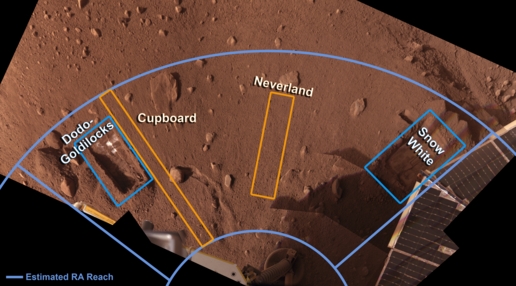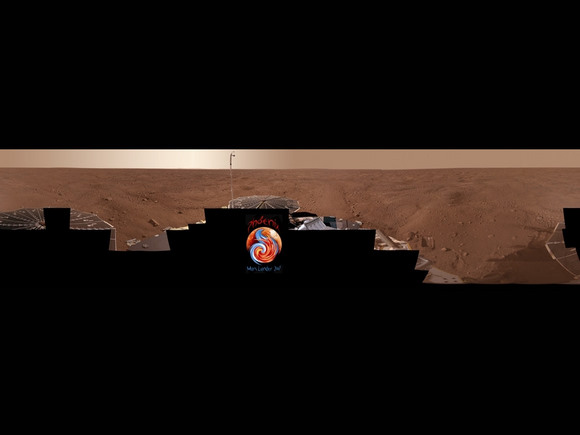[/caption]
The Phoenix Mars lander finally was successful in delivering a fairly fresh sample of Martian soil to the Thermal and Evolved Gas Analyzer (TEGA) oven on Wednesday and a “bake and sniff” test identified water in the soil sample. “We have water,” said William Boynton of the University of Arizona, lead scientist for TEGA. “We’ve seen evidence for this water ice before in observations by the Mars Odyssey orbiter and in disappearing chunks observed by Phoenix last month, but this is the first time Martian water has been touched and tasted.”
The soil sample came from a trench approximately 2 inches deep. When the robotic arm first reached that depth, it hit a hard layer of frozen soil. Two attempts to deliver samples of icy soil on days when fresh material was exposed were foiled when the samples became stuck inside the scoop. Most of the material in Wednesday’s sample had been exposed to the air for two days, letting some of the water in the sample vaporize away and making the soil easier to handle.
“Mars is giving us some surprises,” said Phoenix principal investigator Peter Smith of the University of Arizona. “We’re excited because surprises are where discoveries come from. One surprise is how the soil is behaving. The ice-rich layers stick to the scoop when poised in the sun above the deck, different from what we expected from all the Mars simulation testing we’ve done. That has presented challenges for delivering samples, but we’re finding ways to work with it and we’re gathering lots of information to help us understand this soil.”

Also at the press conference announcing the results, NASA also announced a mission extension for Phoenix, through Sept. 30. The original prime mission of three months ends in late August. The mission extension adds five weeks to the 90 days of the prime mission.
“Phoenix is healthy and the projections for solar power look good, so we want to take full advantage of having this resource in one of the most interesting locations on Mars,” said Michael Meyer, chief scientist for the Mars Exploration Program at NASA Headquarters in Washington.
During the mission extension, the science team will attempt to determine whether the water ice ever thaws enough to be available for biology and if carbon-containing chemicals and other raw materials for life are present.
A full-circle, color panorama of Phoenix’s surroundings was recenlty completed by the spacecraft.
“The details and patterns we see in the ground show an ice-dominated terrain as far as the eye can see,” said Mark Lemmon of Texas A&M University, lead scientist for Phoenix’s Surface Stereo Imager camera. “They help us plan measurements we’re making within reach of the robotic arm and interpret those measurements on a wider scale.”
Original News source: Phoenix News site


Anybody catch the question at the press conference on whether the Phoenix scientists reported to the Presidents science advisors on what MECA found? It seemed the press guy was expecting some announcement. Peter Smith said the data would be analyzed for a few months more. What’s up with that?
Given the fact that the two rovers have been around 4 years longer than planned, I would hope these guys find something for this ship to do beyond September. Maybe they start off with such low expectations for mission lengths, so nobody cries foul if these things blow a serious fuse a few weeks into a mission.
Tested and tried methods – underpromise and overdeliver…
Gary Says:
July 31st, 2008 at 2:04 pm
“Given the fact that the two rovers have been around 4 years longer than planned, I would hope these guys find something for this ship to do beyond September.”
>>>No can do, unfortunately. As Phoenix is so high in latitude on Mars, it will run out of sunlight to power itself much beyond September. It’s electronics heaters will fail, and it will die. Not to mention quite possibly getting buried in CO2 ice after that. This is one mission with a firm timeline on its date with destiny…
In regards to the water – this is great news. It will be interesting to see what else they find as TEGA winds up to 1000 deg. C. I was starting to get a little concerned there – they seemed to be coming perilously close to the end of the main 90 day mission without a great deal of progress or usage of the onboard resources. Time to wind it up a bit more NASA lads ‘n ladies!
the evidence was there, growing stronger over time. now we have the proof. great news!
next question: how much is there?
Just fantastic stuff. I’m impressed that we can try an experiment, get it wrong, learn, try it again and get it right. Instead of a ‘one experiment, one go’ set up that some ships have had in the past.
EXCELENT!!!
We now have proof of something we have ‘known’ for many years. Good work Phoenix, and NASA
Now we go after the question: “Is there liquid water in Mars?”
Drill, boys, drill!
ok.. i did a little dance.. i had pretty much givin up hope that we’d find it… 😀
fair enough,tega registered a steep increase of heat while melting the latest sample of soil/ice which was quiqly deduced to be melting ice to liquid water,but eh, no mention of steam ? why?sorry for being such a doubting thomas.
That’s to bad (on the September timeline), should have sent this one up with some Plutonium in its belly. Oh well.
What a great time in history to be alive! So many discoveries in the last 30 years, the next 30 might be even more exciting! I’m so glad I became interested in astronomy when I was very young.